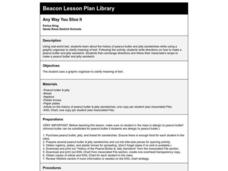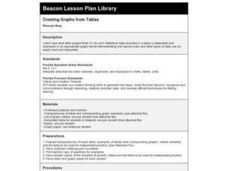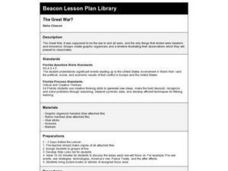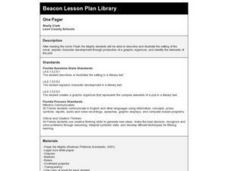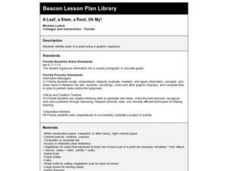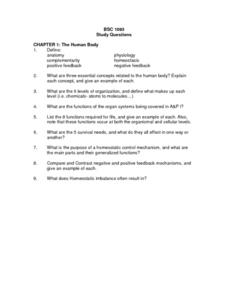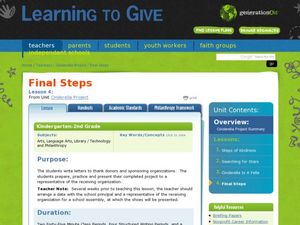Curated OER
Big on Biography
Pupils conduct research for biographical information on a person they select. They write information on note cards and place the information appropriately on a graphic organizer.
Curated OER
Any Way You Slice It
Students read an article on the history of the peanut butter and jelly sandwich and transfer the information onto a graphic organizer. They write instructions on how to make a sandwich and switch with a partner. They make and eat...
Curated OER
Creating Graphs from Tables
Students interpret data from tables and then create a graph to show the same data in a different organization.
Curated OER
Let Us Be Sensible
Learners describe the five senses. They perform an investigation using sensory organs associated with each of the senses. Students identify, describe and extend repeating relationship (pattern) found in common, objects, sounds and...
Curated OER
What is Economics?
Students define economics; Explain the importance and process of making economic choices and decisions; Identify the factors of Production; Determine the goal of entrepreneurship. Students identify and describe the difficulties...
Curated OER
Independence Day
Students discuss and complete activities associated with Independence Day. In this Independence Day lesson, students brainstorm about holidays and their symbols. Students complete organization charts and work in pairs to develop their...
Curated OER
Bountiful Biomes
Students research five different biomes while working in groups. They complete a graphic organizer with the information.
Curated OER
The Great War?
Learners explore The Great War and create graphic organizers and a timeline illustrating their observations.
Curated OER
You Gotta Have A Hat
First graders compare versions of the folktale, 'Caps for Sale.' After listening to both stories, 1st graders utilize a Venn Diagram imbedded in this lesson to produce a graphic organizer detailing the similarities and differences...
Curated OER
One Pager
Learners read the novel, Freak the Mighty and describe and illustrate the setting. They create a graphic organizer that demonstrates the major plot elements and character development.
Curated OER
Nonprofits Are Necessaary
Students research community nonprofit organizations. They identify their purposes and graph them. The search telephone books, websites, and magazines for information on local organizations. They write in journals how nonprofit groups...
Curated OER
Vocabulary: Kansas Prairies
Students explore the ecosystem by reviewing scientific vocabulary terms. In this environmental awareness activity, students identify the differences between abiotic and biotic factors and their relationship to the Earth. Students define...
Alabama Learning Exchange
The Tree of Life
Young scientists use the Internet to evaluate how organisms are classified. They research the phylogeny of organisms and how they are linked in a certain way. Pupils hone research technology skills with their final presentations.
Curated OER
Cans Make a Difference
Students design a service-learning project with pen pals. In this philanthropy lesson, students research various charitable organizations with a pen pal and collect cans in order to get money for a donation. Students write to their pen...
Curated OER
Pond Ecosystem Field Trip
Students investigate the environment by participating in a class trip. In this pond ecosystem lesson, students define a list of vocabulary terms associated with ponds such as invertebrate and metamorphosis. Students attend a field trip...
Curated OER
Exploring Nonprofit Careers
Students interview members of nonprofit organizations about their careers. In this nonprofit careers lesson plan, students research nonprofit careers, prepare questions to ask, and interview those who have those careers.
Curated OER
A Leaf, a Stem, a Root, Oh My!
Students conduct Internet research on plants and complete a WebQuest on vegetable plants. They use a graphic organizer to display their findings, observe actual vegetables and design a salad, noting which part of each plant is included.
Curated OER
You G.O.T. It!
Students complete a T-chart graphic organizer to synthesize and separate information which they have collected.
Alabama Learning Exchange
Mitosis: Divide to Survive
Learners identify the purpose of cellular mitosis. They work in groups of four to use images of animal and plant cell mitosis to illustrate each step in the mitosis process on their graphic organizer.
Curated OER
Economic Concepts and Definitions
Third graders identify producers and consumers in SE Utah and Four-Corners communities. They identify the factors that determine economic development and name some occupations in their community. They show and share their graphic...
Curated OER
The Human Body Study Questions
In this human body study question worksheet, students define 6 words associated with the human body. They answer 8 short answer questions about the organization and function of the organ systems and organization structure of the human body.
Curated OER
Digestion and Nutrition
In this digestion worksheet, students will match 12 terms associated with the digestive system to their correct definition. The vocabulary words review the digestive system organs and their functions.
Curated OER
Final Steps - From Cinderella Project
Students culminate a service project associated with a Cinderella study. In this service project lesson plan, students write letters to thank donors and sponsoring organizations for their donations of shoes. They practice their...
Curated OER
STORY MAPPING: THE HUNDRED DRESSES
Students illustrate and paraphrase each chapter of The Hundred Dresses, creating a graphic organizer through the use of story mapping. After students have completed their story maps, ask for a few volunteers to present theirs to the class.



